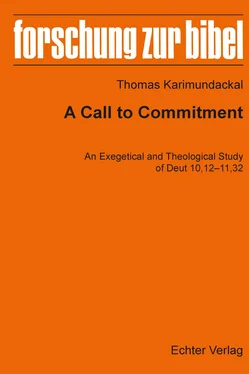1. to carry out a synchronic analysis of the text
2. to arrive at a coherent theological interpretation of the intent of the text
3. to point out the theological significance of the text in the larger context of Deuteronomy and its interpretation
4. to trace possible connections and relations of the text within the compositional frame of Deuteronomy and to the rest of the Old Testament
5. to draw out its contextual meaning and significance for the world of today which is increasingly becoming pluri-religious and multicultural.
4. Methodology and areas of the research
Following a synchronic approach, this thesis focuses on a textual study of Deut 10,12-11,32 in its final form. 6The text is interpreted taking into account its grammatical, syntactic and semantic particularities. Reading the text intra-textually and inter-textually, this study looks into the contextual and theological significance of 10,12-11,32 in Deuteronomy. Throughout this study the text is read and interpreted while keeping in mind the ‘faith-purpose’ of the authors of Deuteronomy. 7
Therefore, a synchronic analysis will be carried out through:
1. the delimitation and the contextual analysis of the text
2. the translation and text-critical analysis of the text
3. the dynamics and structural analysis of the text
4. the literary and narrative analysis of the text
5. the inter-textual analysis of the text
6. the theological interpretation of the text and its applications for the reader of today
5. Itinerary of the study
This study is organized in four chapters. The first chapter concentrates on a threefold examination of Deut 10,12-11,32, namely the delimitation of the text, its context, and its translation with text-critical observations and evaluations. The delimitation and the contextual analysis of the text is to show that Deut 10,12-11,32 is an independent literary unit and that it is placed meaningfully within a larger literary block of Deuteronomy with a theological purpose. The Hebrew text is translated as faithfully as possible, and relevant text-critical observations are made in order to show that the investigated text reflects the original one in the closest way.
In the second chapter the structure of the text is examined and its dynamics are pointed out. The literary division of the text is carried out by applying various criteria, such as changes in the character, time, place, theme, narrative communication, vocabulary etc. It is followed by identifying the movement of the text as a whole and various movement patterns within the subunits. Criteria like communication structure, sequence of time, change of place, privileged positions - especially beginning and end - formal structure, development of themes, succession of words and phrases and their connections, continuations, intensifications, contrasts etc. are used to identify various elements of the movement within the text.
In the third chapter the text is interpreted verse by verse or by taking smaller units in accordance with the structure arrived at. At every stage of interpretation each subunit is taken up separately, and then its literary characteristics are examined from a synchronic perspective. This is followed by a detailed grammatical, syntactic and semantic analysis of key words, phrases and clauses to bring out their exegetical and theological significance in Deuteronomy.
The final chapter concludes the study by summarizing its exegetical and theological findings. First of all it illustrates the hermeneutical function of 10,12-11,32 in Deuteronomy. Secondly, in the context of the various elements of the Deuteronomic theology different theological themes of 10,12-11,32 are briefly presented and summed up, and it is shown how 10,12-11,32 serve as a key to the theology of Deuteronomy. Finally a short theological reflection on the text and its relevance for a contemporary reader is offered from a faith perspective.
1For a survey of various attempts to define the term parenesis in Deuteronomy, see TIFFANY, Parenesis, 3-19. Having evaluated the earlier approaches to define the term parenesis, Tiffany defines parenesis as “a second person, direct address form which appeals to the will of the addressee (individual or community) and whose intention is to urge obedience to or to discourage transgression of an order”, ibid., 312; see also ibid., 19-25, 307-313. According to him, considering the textual intention, which is expressed both in content and syntax, parenesis differs from an ‘order’ which is also normally addressed in the second person. While an order is given by means of a command or prohibition to establish a norm of action, parenesis focuses not on the norm of action but on the addressee to motivate and encourage him/her to comply with an order, cf. ibid., 307-308; see also ibid., 20-22. However, the legitimacy of his distinction between parenesis and order is questionable, as we see a formal mixing of the two in many instances in Deut 5-11. See DEROUCHIE, Call, 95-200, for a detailed text-linguistic analysis of Deut 5-11 which merges these two without a significant semantic distinction between them. For a grammatical distinction between parenesis and order, see RICHTER, Recht, 190. For third person command forms, see GERSTENBERGER, Wesen, 66-70.
2For a comprehensive survey of the the historical development of scholarship on Deuteronomy up to the present, see OTTO, Deuteronomium I, 62-230.
3I would like to mention only a few of them which significantly contributed to the synchronic study of the pareneses in Deuteronomy. The seminal work of Lohfink’s Pontifical Biblical Institute dissertation, Hauptgebot, initiated a new approach to the entire scholarship of Deuteronomy by providing a formal and stylistic analysis of Deut 5-11. Like Lohfink, López in his Pontifical Biblical Institute dissertation, Un Dios, continued to analyze the key terms, forms and literary patterns in Deut 6-11 and established many more layers in Deuteronomy’s compositional history. Building on his doctoral dissertation López has published a series of articles concerning the style, literary structure, and redactional history of Deut 5-11 to point out the level of compositional unity in these chapters, cf. Deutéronome, RB 84, 481-522; idem, Deutéronome, 5-49; idem, Deut VI, 161-200; idem, Deut VI, 59-91; idem, En los umbrales, 37-64; idem, Dt 8, 21-54; idem, Peuple, 438-463. Tiffany in his dissertation, Parenesis, attempted to provide a form critical and structural analysis of Deut 5-11 on the basis of the parenetical discourses in Deut 5-11. DeRouchie in his dissertation, Call, tries to establish the literary structure and theological agenda of Deut 5-11 on objective linguistic grounds such as form, semantic meaning, and discourse function of a number of linguistic features. The following studies are also contributed significantly to the understanding of the parenetical discourses in Deut 5-11, although their focus is diachronic: RANCK, Relationship; ACHENBACH, Israel; MERENDINO, Dt V-VI, 80-83; PECKHAM, composition, 217-240; BREKELMANS, Deuteronomy 5, 164-173; VERMEYLEN, Narratives, 174-207.
4For a list of the relevant commentaries, see the section on commentaries in the Bibliography.
5As far as I know there is only one research article that specifically deals with the final parenesis, and that especially unravels the elements of the theology of the covenant, cf. VEIJOLA, Bundestheologie, 206-221. However, this article is elaborated with regard to 10,12-11,32 in his commentary on Deuteronomy, cf. VEIJOLA, Deuteronomium, 242-259.
6Various steps in the development of this study follow closely the guidelines proposed by FISCHER, Wege, 1-34.
Читать дальше












